Scientists in Abu Dhabi have solved the mystery of how an open body of water formed in the middle of thick ice during the Antarctic winter.
The Maud-Rise Polynya, the scientific name for an area of water where you would expect to find ice, was spotted in mid-September 2017 in Antarctica’s Lazarev Sea.
At the time of the discovery, the body was around 9,500 square kilometres in size and grew to 800,000 square kilometres within a month, before eventually merging with the open ocean at the beginning of the summer.
Scientists have been puzzled by the phenomenon since 1974, which is the last time it was known to have occurred in the same location.
To solve the mystery, scientists used a combination of satellite observations and data to check the weather at the time.
It showed how strong winds from severe and frequent cyclones had caused the sea pack ice to break up and move in opposite directions. The area of unfrozen ocean, from underneath the pack ice, filled the space left behind.
“The cyclonic winds generated sea ice divergence by pushing the ice away from the cyclone centre: to the east north of it and to the west south of it, which led the reoccurrence of the Maud Rise polynya in mid‐September 2017,” said the research paper, which was led by NYU Abu Dhabi research scientist Diana Francis and co-authored by Clare Eayrs and David Holland, from NYU AD’s Centre for Global Level Sea Change, and Juan Cuesta of the University of Paris-East.
Once opened, the Polynya works like a window through the sea ice, said Ms Francis, transferring huge amounts of energy between the ocean and the atmosphere.
"Because of its large size, a mid-sea Polynya is capable of impacting the climate regionally and globally as it modifies the oceanic circulation. It is important for us to identify the triggers for their occurrence to improve their representation in models and their effects on climate," she said.
And due to global warming, they could occur more often in the future, said Ms Francis.
"Given the link between Polynya and cyclones we demonstrated in this study, it is speculated that Polynya events may become more frequent under warmer climate because these areas will be more exposed to more intense cyclones.
“Previous studies have shown that under a warmer climate, polar cyclone activity will intensify, and extratropical cyclone tracks will move toward Antarctica which could decrease the sea-ice extent and make Polynya preconditioned areas closer to the cyclones formation zone," Ms Francis added.
Early explorers who ventured into a Polynya often believed they had discovered a new ocean.
But even with the advent of technology, they are still not completely understood by scientists.
Some remain open for years at a time, while others only for weeks or months.
According to the National Snow and Ice Data Centre, polynyas are important for wildlife.
In addition to providing access to between the ocean and the atmosphere for a variety of animals like seals and penguins, they bring nutrients like phytoplankton to the surface.
“Phytoplankton are microscopic plant-like organisms that form the basis of the marine food chain. During the summer, Antarctic polynyas are one of the most biologically productive regions in the world's oceans,” said the NSIDC website.







